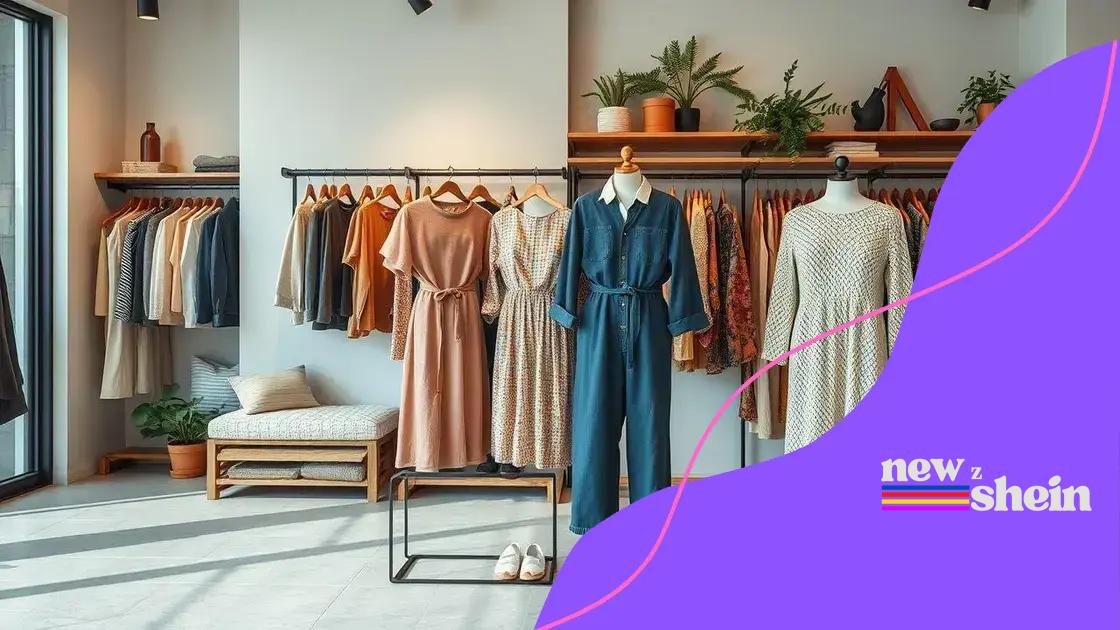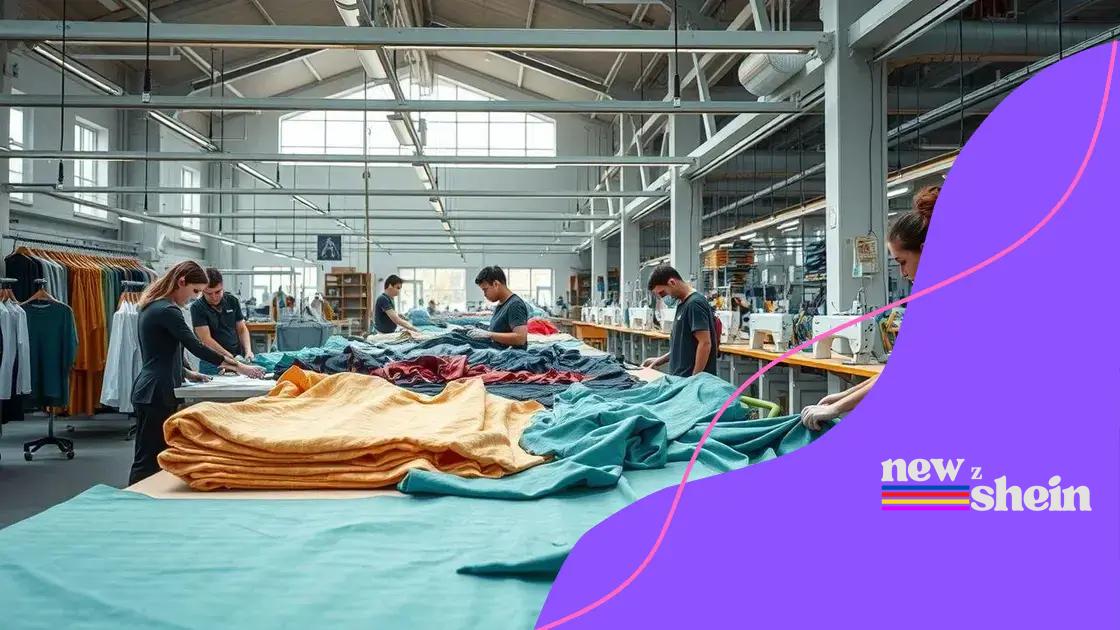Shein’s sustainable fashion line perks: what you need to know

Shein’s sustainable fashion line combines eco-friendly materials and ethical production practices, making it a responsible choice for consumers who want stylish, environmentally conscious clothing.
Shein’s sustainable fashion line perks are turning heads in the fashion world. Have you ever considered how your shopping choices impact the environment? Let’s dive into what makes this line special and how it can benefit your wardrobe.
Understanding Shein’s approach to sustainability
Understanding Shein’s approach to sustainability begins with recognizing their commitment to eco-friendly practices. Shein aims to offer stylish clothing while being conscious of the environmental impact of fashion. This balance is crucial in today’s market.
One way Shein demonstrates its sustainable practices is through its use of recycled materials. They are focusing on reducing waste in the manufacturing process, which significantly lowers their carbon footprint. With an increasing number of consumers prioritizing sustainability, Shein’s approach is timely.
Key Elements of Shein’s Sustainability Strategy
Several factors contribute to Shein’s strategy:
- Utilizing recycled fabrics such as polyester and cotton, which minimizes the need for new resources.
- Collaborating with eco-conscious suppliers to ensure ethical production practices.
- Implementing a transparent supply chain to allow consumers to understand where their clothes come from.
- Encouraging responsible consumption through various initiatives and campaigns.
Additionally, Shein is focused on increasing awareness about sustainable fashion. They often provide tips and resources to help customers make informed choices. This commitment to education empowers consumers to think critically about their purchasing habits.
While Shein continues to grow, the challenge remains to balance style and sustainability. By addressing this issue head-on, they are setting an example for fast fashion brands, showing that it is possible to do both. The fashion industry must evolve, and Shein’s initiatives are a step in that direction, paving the way for future innovations in sustainable design.
Benefits of shopping from the sustainable line
Shopping from Shein’s sustainable line comes with many advantages for both consumers and the environment. This range provides stylish options that align with the growing demand for eco-friendly fashion choices. When you choose sustainable clothing, you not only look great but also contribute to a healthier planet.
One major benefit is the use of eco-friendly materials. Shein’s sustainable line features garments made from recycled fabrics, which helps in reducing waste and conserving resources. Wearing clothes made from such materials means you are part of a larger movement toward sustainable living.
Advantages of Choosing Shein’s Sustainable Line
Consider some of these key benefits:
- Promotes environmental responsibility through reduced carbon footprints.
- Encourages ethical manufacturing practices that protect workers’ rights.
- Offers trendy designs that do not compromise on fashion.
- Increases awareness of sustainable fashion in everyday shopping.
Moreover, shopping sustainably can also be a personal journey toward mindfulness. It encourages consumers to think about their clothing choices and their impact on the world. By supporting Shein’s sustainable line, you are making a commitment to smarter shopping.
The variety that exists in this line allows you to mix and match styles. From casual wear to more formal options, the collection is diverse, catering to different tastes while maintaining a focus on sustainability. You no longer have to sacrifice style for conscience; you can have both!
How Shein’s sustainable products are made

Understanding how Shein’s sustainable products are made gives insight into their commitment to eco-friendly fashion. The process begins with selecting materials that are better for the environment, such as recycled polyester and organic cotton. These choices help reduce waste and the demand for new resources.
Shein utilizes advanced technology in their production lines. This technology not only speeds up manufacturing but also ensures high accuracy in fabric cutting, which minimizes leftover materials. Such practices reflect a serious approach to sustainability.
Steps in the Production of Sustainable Products
Here are key steps involved:
- sourcing recycled materials that lessen environmental impact.
- employing ethical labor practices to ensure fair treatment of workers.
- monitoring the entire supply chain for transparency.
- adopting innovative designs that reduce waste.
The manufacturing process at Shein also emphasizes efficiency. By optimizing their logistics, they ensure that the transportation of goods is eco-friendly. This further enhances their overall sustainability mantra.
In addition, Shein is committed to educating its consumers about the benefits of sustainable fashion. With campaigns that raise awareness, they encourage shoppers to consider the impact of their choices. The more informed consumers become, the more likely they are to support sustainable practices.
This holistic approach not only aligns with current trends in eco-conscious shopping but also paves the way for a more sustainable fashion industry.
Comparing Shein’s sustainable line to traditional fashion
Comparing Shein’s sustainable line to traditional fashion highlights significant differences in how clothes are made and consumed. Unlike traditional fast fashion, which often prioritizes speed over sustainability, Shein focuses on creating eco-friendly products without compromising style.
One of the main aspects to consider is the materials used. Shein’s sustainable line incorporates recycled fabrics and organic materials, while traditional fashion often relies on new, synthetic textiles. This difference reduces waste and helps preserve the environment.
Key Differences Between Shein’s Sustainable Line and Traditional Fashion
Here are some important factors to compare:
- Environmental Impact: Shein’s line uses methods that lower carbon emissions, while traditional fashion can significantly contribute to pollution.
- Ethical Labor Practices: Shein emphasizes ethical production, whereas traditional brands may not guarantee fair treatment for workers.
- Fashion Choices: Shein offers a stylish range from sustainable collections, ensuring consumers don’t have to sacrifice fashion for eco-conscious choices.
- Awareness and Education: Shein actively promotes awareness about sustainability in fashion, which is often overlooked by traditional brands.
In addition to these differences, Shein’s approach encourages shoppers to think critically about their purchases. Traditional fashion usually focuses on quick turnover of styles, leading to frequent buying and disposal of clothing. This cycle creates more waste, which is detrimental to our planet.
By choosing Shein’s sustainable products, consumers engage in a more thoughtful shopping experience. They support a movement towards sustainable fashion, which is gaining momentum in the industry. As awareness increases, more brands may follow suit to meet consumer demand for eco-friendly options.
Future implications for sustainable fashion in the industry
The future implications for sustainable fashion in the industry are becoming increasingly significant as more brands, like Shein, lead the charge. This shift towards eco-friendly practices is not just a trend; it reflects a deeper understanding of consumer responsibility and environmental impact.
As awareness about fashion’s ecological footprint grows, brands are pressured to adopt sustainable practices. This means more companies are looking to integrate recycled materials and ethical sourcing into their collections. The public’s demand for transparency forces the industry to rethink traditional methods.
Key Trends and Changes in Sustainable Fashion
Several important trends are shaping the future of sustainable fashion:
- Increased Use of Technology: Innovations in fabric production that utilize less water and energy are becoming mainstream.
- Consumer Education: Brands and organizations are focusing on educating consumers about sustainable choices, encouraging them to shop mindfully.
- Collaboration Among Brands: Many companies are collaborating to share sustainable practices and resources, creating a united front.
- Government Regulations: As sustainability becomes a priority, governments may enact stricter regulations on fashion production.
Moreover, as millennials and Gen Z lead the conversation on sustainability, companies that fail to adapt could fall behind. These generations value brands that reflect their commitment to the environment. They are willing to support companies that prioritize sustainability, signaling a clear shift in market dynamics.
Ultimately, the implications of shifting towards sustainable fashion will impact not just production processes, but also consumer behavior and brand loyalty. As these changes take root, we will likely see a more responsible and transparent fashion industry emerge, one that values the planet as much as profits.
FAQ – Frequently Asked Questions about Shein’s Sustainable Fashion Line
What materials are used in Shein’s sustainable line?
Shein’s sustainable line primarily uses recycled fabrics and organic materials that help reduce environmental impact.
How does Shein ensure ethical labor practices?
Shein is committed to ethical production by working with suppliers who guarantee fair treatment and safe working conditions for their employees.
What makes sustainable fashion important?
Sustainable fashion reduces waste, conserves resources, and promotes ethical practices, ensuring that clothing production does not harm the planet.
How can consumers support sustainable fashion?
Consumers can support sustainable fashion by choosing eco-friendly brands, promoting awareness, and making informed purchasing decisions.





